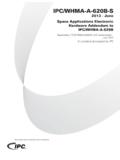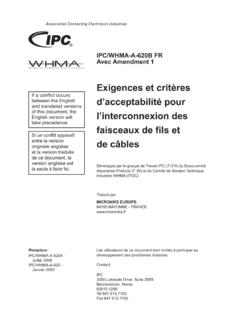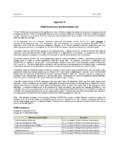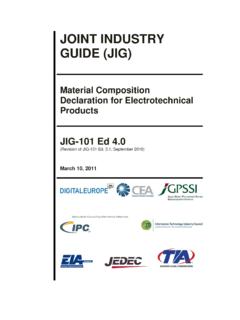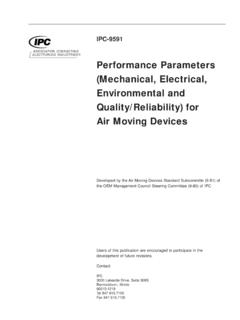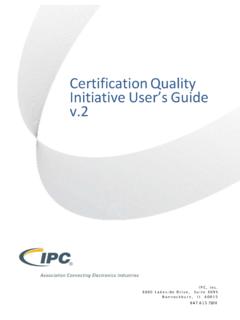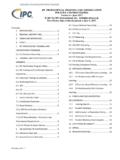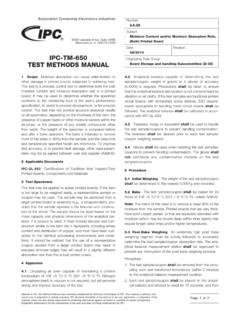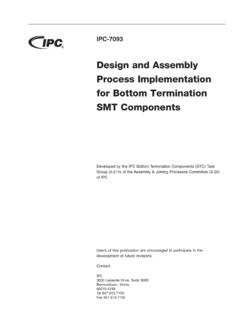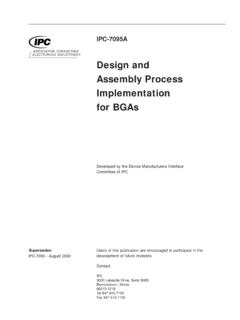Transcription of JOINT INDUSTRY STANDARD - IPC
1 JOINTINDUSTRYSTANDARDR equirements forSoldering FluxesAmendment 1 IPC J-STD-004 BAmendment 1 November 2011 Requirements for Soldering FluxesEditorial PurposeThe purpose of this STANDARD is to classify and characterize tin/lead and lead-free soldering flux materials foruse in electronic metallurgical interconnections for printed circuit board assembly. Soldering flux materials include the fol-lowing: liquid flux, paste flux, solder paste, solder cream as well as flux-coated and flux-cored solder wires and is not the intent of this STANDARD to exclude any acceptable flux or soldering material; however, these materials must pro-duce the desired electrical and metallurgical in Note 1 Table 1-1 Flux Identification SystemNote 1. Halide measuring < by weight in flux solids may be known as halide-free. The quantitative halide methoddetermines the amount of halide present (see Appendix B-10).Remove the Prefix BS from the Document British StandardsEN 14582 Characterization of waste.
2 Halogen and sulfur content. Oxygen combustion in closed systems and 5 New HalideIn this STANDARD , halogen ions are known as halides. Specifically, chlorine ion is known as chloride or (Cl-),bromine ion is known as bromide or (Br-), fluorine ion is known as fluoride or (F-), iodine ion is known as iodide or (I-)and halogen compounds that have ionic character are termed halide HalogenIn this STANDARD , halogen is the term for all chlorine (Cl) and/or bromine (Br) in compounds. These twotypes of compounds are referenced based upon the EN 14582 test method (see ). Low Halogen Flux (Cl and Br)For the purpose of this STANDARD , low halogen materials contain 1000 ppm ( )Br, and 1000 ppm ( ) Cl. Sample preparation should be Resin FluxPrimarily composed of synthetic resins and/or natural resins other than rosin Rosin FluxPrimarily composed of natural rosin, extracted from the oleoresin of pine trees and refined. The rosinsusedshallhave a minimum acid value of 130 as determined per ASTM D-465.
3 A synonym for rosin is Row at the Bottom of the Table and Replace Note 1 Table 3-1 Preparation of Flux Forms for TestingHalogen ContentFlux residue afterreflowFlux residue afterreflowFlux residue afterreflow; metalremovedFlux residue afterreflow; metalremovedFlux residue afterreflow; metalremoved1. Testing an as-received flux containing >50% water may give a failing result due to the presence of water, so it may be oven dried at 80 2 C for 1 hour+15 minutes/-0 minutes and reconstituted (dissolved in the appropriate solvent) per IPC-TM-650, Method for use in this test. If the sample is tested inthe reconstituted state, results from both the as-received and reconstituted samplesshallbe Halide ContentFlux Typeshallbe identified using 0 or 1 to indicate the absence or presence of halide in theflux, where < halide is defined as halide free. The absence or presence of halideshallbe determined per the testmethod outlined in Table 3-2 and the corresponding paragraphs.
4 The quantitative halide method determines the amount ofhalide present (see Appendix B-10). Testing for halide content does not include evaluation for halogen content. A materialwith a 0 indicator may contain non-ionic halogen. See and 2011 IPC J-STD-004B - amendment 11 Editorial Change to Note 3-2 Test Requirements for Flux ClassificationNote 1. This method determines the amount of halide present (see Appendix B-10).Replace Quantitative Halide Content TestsQuantitative halide testsshallbe used to determine the concentration of chlo-ride (Cl-), bromide (Br-), fluoride (F-) and iodide (I-) in liquid fluxes or extracted flux solutions. The total halide content ofthe flux is obtained by adding together the Cl-,Br-,F-, and I-contents. The halide content is reported as the weight per-centage of halide of the solid (nonvolatile) portion of the flux. The combined concentration of chlorides, bromides, fluo-rides, and iodidesshallbe determined in accordance with IPC-TM-650, Test Method The solids content is deter-mined in accordance with First Bullet Reporting SIR Test Results All SIR measurements on all test patternsshallexceed the 100 M requirement after 24 hours of Resistance to ECM TestingThe resistance to ECM testingshallbe assessed in accordance with IPC-TM-650,Test Method , using the 65 C 2 C, RH condition.
5 ECM patternsshallbe prepared per IPC-TM-650, Method using the product-specific reflow or wave soldering Optional Chlorides and Bromides by Silver Chromate MethodThe presence of chlorides and bromides may bedetermined in accordance with IPC-TM-650, Test Method Optional Fluorides by Spot TestThe presence of fluorides may be determined in accordance with IPC-TM-650,Test Method New Optional Halogen Content TestWhen reporting of halogen content is requested, the concentration of Cl and Brshallbe determined using the EN 14582 oxygen bomb method followed by ion chromatography per IPC-TM-650, Alternate test methods may be used AABUS. Halogen levels measured are impacted by the sample preparationmethod selected; therefore, specific sample preparation detailsshallbe included in the test report (see Appendix A). Fluxmaterials that do not contain metalshallbe tested in the final reflowed residue form. Samples that contain metalshallbereflowed or extracted to obtain the flux portion of the material.
6 The metal must be discarded and weight of the metal shouldnot be considered in the calculation for halogen content. Alternate sample types ( , testing of raw flux) may give vary-ing results andshallbe AABUS. A flux residue is considered low halogen if the maximum halogen values are in accordancewith Table New TableTable 3-3 Halogen Content in Low Halogen MaterialsMaximum Quantitative Halogen 1000 ppm ( ) Br, and 1000 ppm ( ) ClIPC J-STD-004B - amendment 1 November 20112 Insert a New Row Between Fungus and Wetting Balance Table 4-1 Qualification, Quality Conformance and Performance Testing for FluxHalogen ContentEN A Example Qualification Test ReportAdd Note Superscript to SIR and 100 M LLCleaned or no-cleanstate 100 M MMCleaned 100 M <1 decade dropLLCleaned or no-clean<1 decade dropMMCleaned<1 decade dropHHAdd New Row Between Fungus (Optional) and Wetting Balance (Optional) 14582 November 2011 IPC J-STD-004B - amendment 13 Add New Notes 1 and 2 for Example Qualification Test ReportNote 1:Required Information for Cleaned ProductCleaning Procedure for SIR/ECM Testing:Cleaning Material:Cleaning Equipment.
7 Cleaning Process Parameters:Note 2:Required Information for Halogen DeterminationProcedure used to extract metal, if applicableReflow ProfileSubstrate used to collect reflowed sampleresidueReflow AtmosphereHalogen Determination via Ion Chromatography Weight of ion (g) in sample =[Conc. of Ion in Extract( g /mL)]x[Dilution Factor]x[Dilution Volume(mL)]x10-6 Percent of ion in residue =Wt of Ion(g)in SampleWt (g ) of Fluxresiduex 100 IPC J-STD-004B - amendment 1 November 20114 Appendix B NotesRemove Prefix BS from Document Number BS-EN 14582B-10 Halide versus Halogen ContentIPC-TM-650, Method , is intended for the detection of ionic halides. Ionichalide content is not to be confused with halogen content. Halogen content should be tested per EN 14582 or AABUS. AnOxygen Bomb is utilized to dissociate the covalently bound halide and this product is dissolved and analyzed via ion chro-matography. For additional information seeA Review of Test Methods and Classifications for Halogen-Free Soldering Mate-rialsbyJasbir Bath, Gordon Clark, Tim Jensen, Renee Michalkiewicz and Brian Toleno published in the 2011 IPC APEX conference New B-12 ParagraphsB-12 Creep Corrosion IPC round-robin testing is underway to evaluate creep increasing adoption oflead-free PWB surface finishes, along with increasing product deployments in more corrosive environments, the electronicsindustry is observing increased occurrences of corrosion-induced product failures.
8 Particularly, creep corrosion on immer-sion silver has been observed to cause product failures after very short service periods in G2 (Moderate severity level withcopper corrosion rate between 30 and 100 nm [ mil and mil] per month as defined in , Environmental Conditions for Process Measurement and Control Systems: Airborne Contaminants. ) and worse environ-ments, in some cases less than one year. Creep corrosion is the mass transport process in which solid corrosion products(typically sulfide and chloride) migrate over a surface without the influence of an electric field. First, a site is required forcreating corrosion product, for example ImAg or OSP plated pads. Additionally, the surface between the pads has to be ableto support creep of the corrosion product which will eventually cause an electrical short circuit between adjacent pads. Nei-ther clean FR-4 nor clean solder mask surfaces support creep of copper sulfide, the typical creeping species observed in fieldfailures.
9 However, residues left on the surface by certain types of fluxes form a surface that allows for creep and are highlyactive for supporting creep of copper sulfide corrosion simulation of creep corrosion in the laboratory has to take the highly surface sensitive nature of creep corrosion intoconsideration. Mixed flowing gas testing can simulate environmental conditions in the global market place and has beensuccessfully used previously to generate creep corrosion on electrical contacts (metallic surface) and integrated circuits(dielectric surface). Recently, creep corrosion was successfully reproduced on printed circuit boards using mixed flowing gas(MFG) testing. The previous inconsistency in generating creep corrosion on ImAg and OSP coated samples using MFG liesin the failure to recognize the highly surface sensitive nature of creep corrosion. Test vehicles containing only surface fin-ishes and solder mask without going through the assembly process are not appropriate samples for generating and under-standing creep corrosion, as clean FR4 and solder mask surfaces do not support creep corrosion.
10 Searching for creep corro-sion resistant PWB final finishes and fluxes should be done on an assembled board with solder mask and flux. The MFG testprovides a viable and realistic accelerated aging test for creep corrosion. IPC 3-11g is currently conducting round robin testto verify the validity of using MFG for simulating creep corrosion and develop next generation STANDARD corrosion test C. Xu, J. Smetana, J. Franey, G. Guerra, D. Fleming, W. Reents, D. Willie, A. Garcia I., G. Encinas and X. Jiang, CreepCorrosion of PWB Final Finishes: Its Cause and Prevention, APEX C. Xu, W. Reents, J. Franey, J. Yaemsiri and J. Devaney Creep Corrosion of OSP and ImAg PWB Finishes, IPC 3-11G Corrosion of Metal Finishes Task Group in 2011 IPC J-STD-004B - amendment 15847-615-7100 tel 847-615-7105 fax Lakeside Drive, Suite 309 SBannockburn, IL 60015 Association Connecting Electronics Industries
